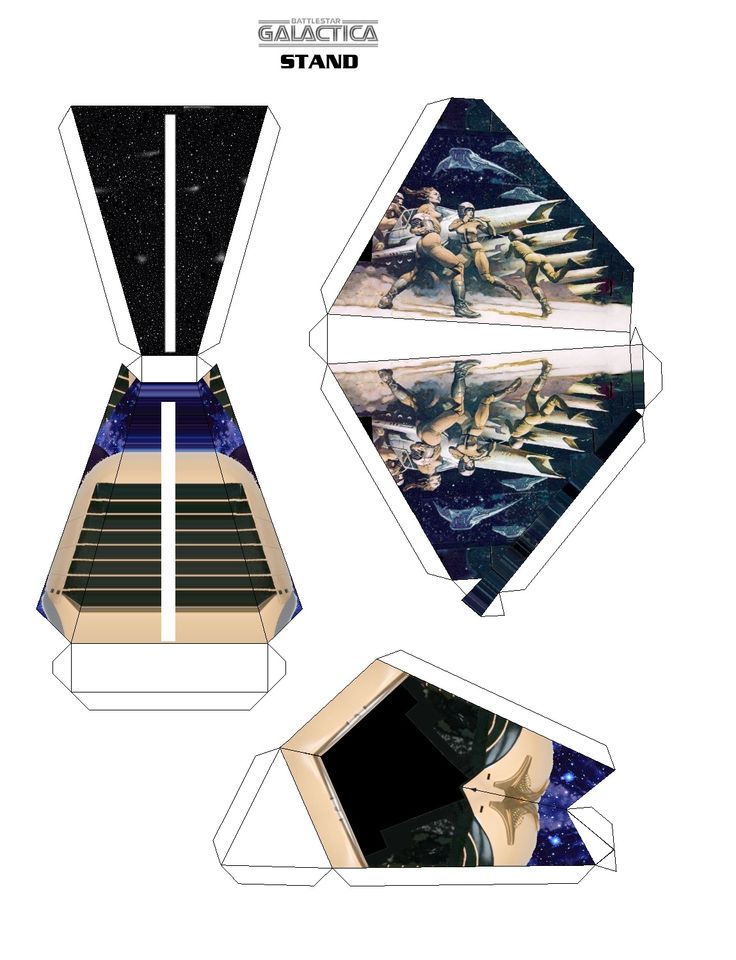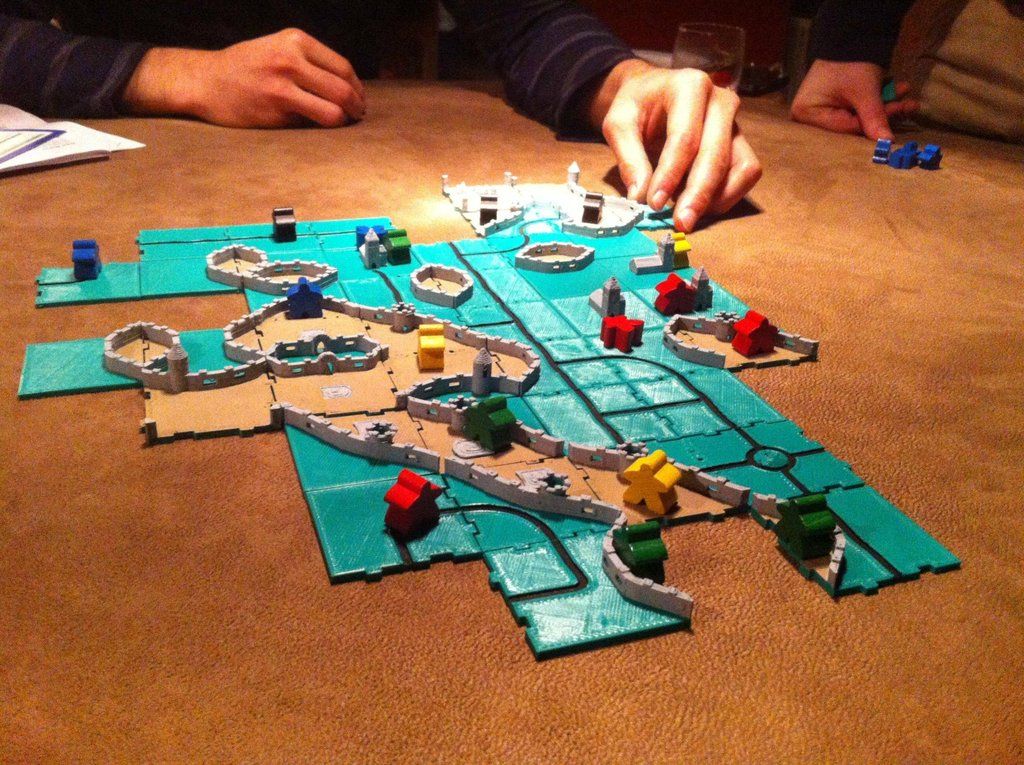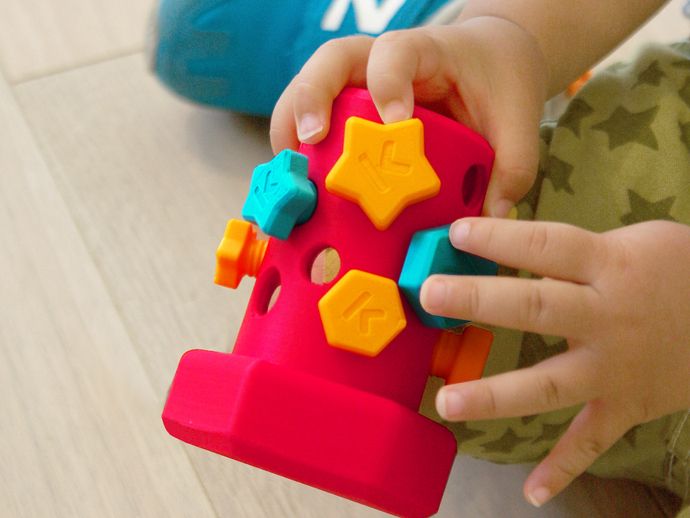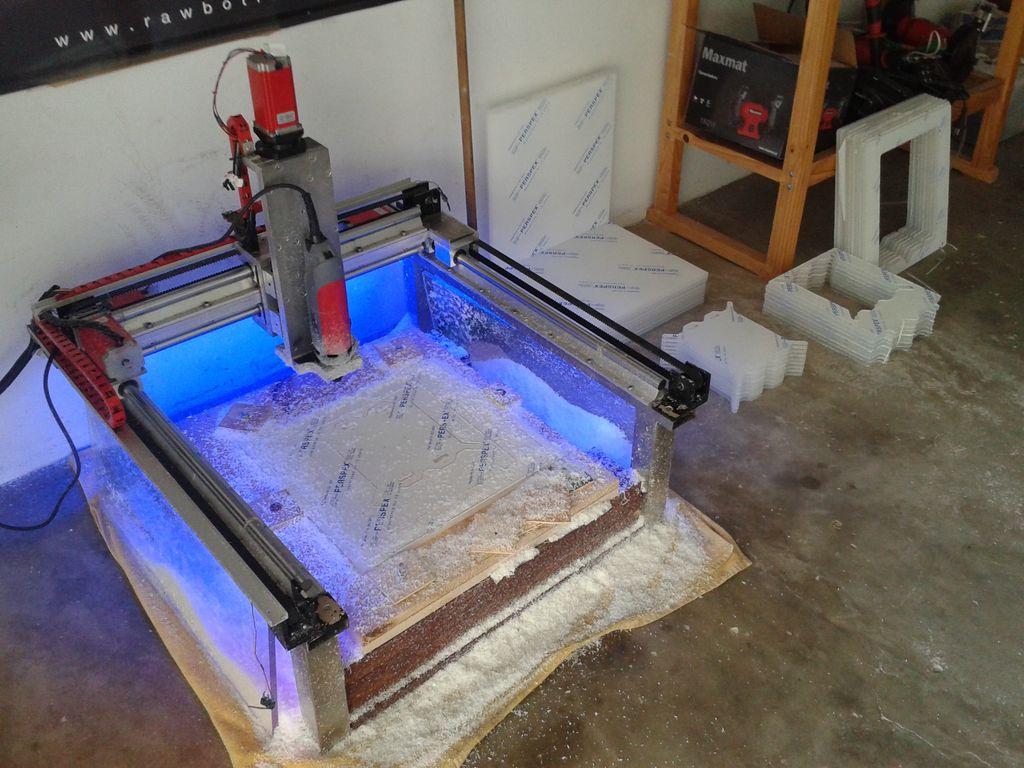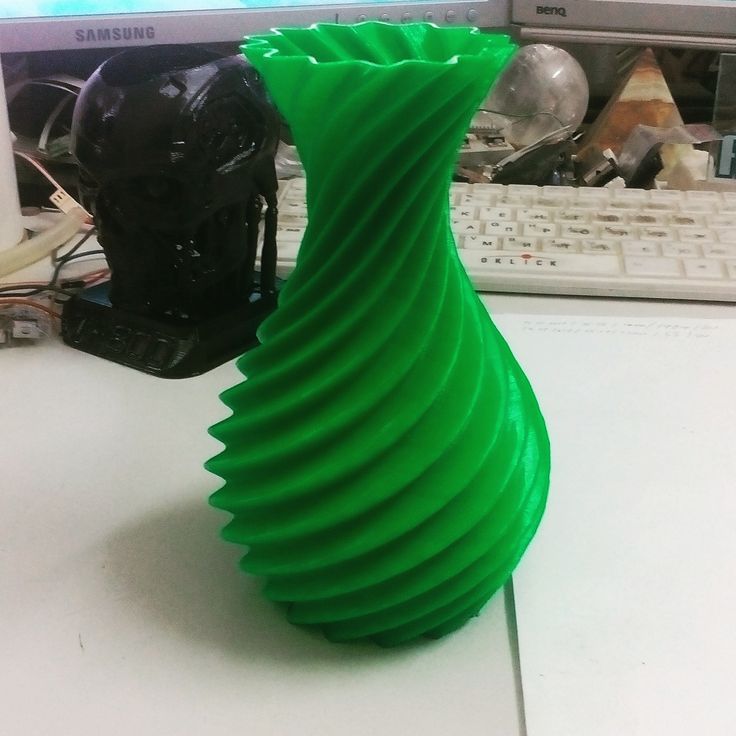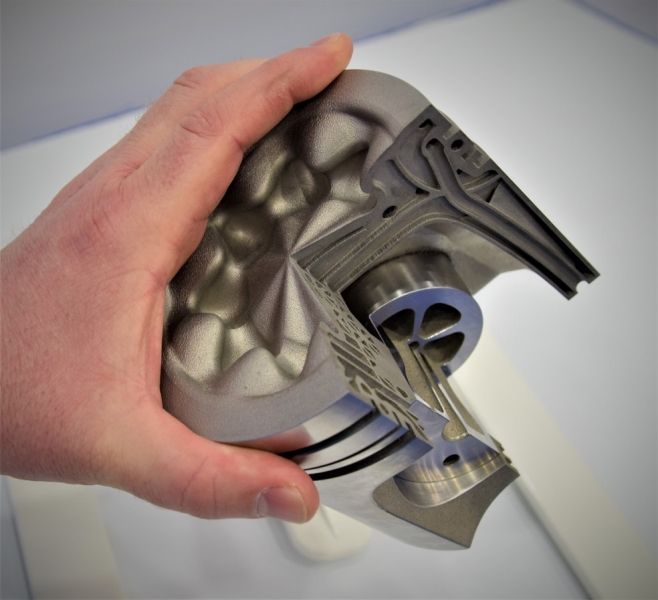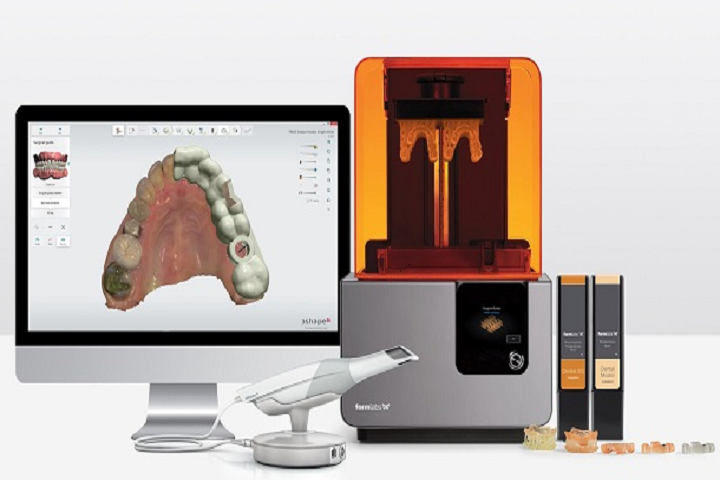Rostock delta robot 3d printer
Rostock - RepRap
Rostock Documentation
Main page | Rostock Buyer's Guide | Rostock Build Manual | Rostock User Manual | Rostock improvements
Rostock
Release status: working
| Description | Rostock is a delta robot 3D printer prototype. |
| License | GPL |
| Author | User:Johann |
| Contributors | |
| Based-on | Helium Frog Delta Robot |
| Categories | Delta, Tall |
| CAD Models | GitHub |
| External Link | Thingiverse |
Rostock is a linear delta robot 3D printer prototype, built in 2012 by Johann in Seattle, USA.
Several variations have taken root, including: Kossel, Rostock mini, Rostock MAX, Rostock-Montpellier, Rostock Prisma, Delta-Pi, Cerberus, cOssel, Cherry Pi and ProStock. Both the MOST delta and their Open Source Metal 3D Printer also uses an inverted form of this design.
Contents
- 1 Design Goals
- 2 Videos
- 3 Firmware
- 4 Frequently Asked Questions
- 5 Future
- 6 Links
Design Goals
- Build volume: 200x200x400 mm (8x8x16 inches).
- Footprint: 300x350 mm (12x14 inches).
- Print surface: 200x200 mm heated glass which never moves.
- Mass of end effector with hotend: less than 50 grams.
- Positioning speed: up to 800 mm/s in all 3 directions.
- Positioning accuracy: at least 30 steps/mm in all 3 directions.
- Simplicity: fewer than 200 parts.
- Hardware cost: less than $500 USD.
Videos
http://youtube.com/user/jcrocholl/videos?query=rostock
<videoflash>3UOq-CQsbNo|640|360</videoflash>
<videoflash>nkAwOxA0lq8|640|360</videoflash>
Firmware
Many firmwares support Delta printers out of the box. See their individual instructions on how to configure them.
See their individual instructions on how to configure them.
Frequently Asked Questions
- How do you adjust the height of the print surface ?
You can adjust the following line in Configuration.h and then recompile and upload the firmware:
// The home position of the print head. // For Rostock this means top and center of the cartesian print volume. #define Z_HOME_POS 402 // Distance between nozzle and print surface after homing.
For micro-calibration, use the adjustable endstop screws in the vertical carriages, see #Calibration above.
- Should the heat bed be mounted on top of a piece of insulation or cork ?
Yes, it's definitely a good idea. Cork or another kind of thermal insulation under the heatbed has two benefits:
- It lowers the times required for the heatbed to reach the PLA (around 60C) or ABS (around 100C) ideal heatbed temperatures.
- It protects whatever material is under the heatbed from excessive heat radiated by the hot heatbed.
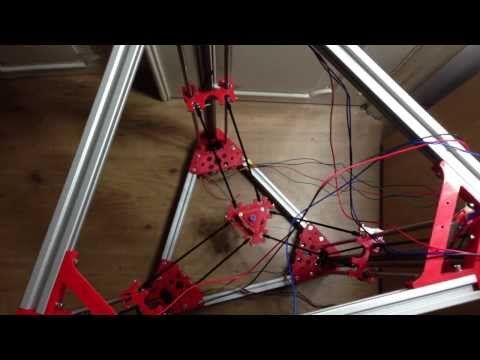
See Heated Bed Insulation for further details.
- Is your heat bed mounted element side up ?
Yes, the etched copper side is in direct contact with the glass. You can see the LEDs and contacts in the front just next to the glass edge. But I have not actually connected my heated bed wires yet, because I print only PLA and it sticks perfectly to blue painters tape, even without heating the platform. I will connect the heated bed wires if I ever have problems with detaching corners, otherwise remove the heated bed completely at some point.
- Should the heat bed be mounted so it can be leveled ?
No, I think the print platform should be attached as tightly as possible to the frame, with full surface contact, possibly with cork insulation between bed heater and plywood. Then you can level the first print layer with the three micro-adjustable endstops, see #Calibration. Also make sure that the vertical smooth rods are orthogonal to the bottom plywood, otherwise your printed objects will be slightly skewed.
- Will it matter if the hot end is not centered in the platform opening ?
It might work okay but there are some minor issues:
- You may need to design and print a special asymmetric attachment for the bowden tube.
- The nearest inside of the moving platform may get soft because of the heat from the hotend.
- Your prints will not be centered on the print surface (closer to one edge) but this may be adjusted in your Slicer settings.
- Why does the printer pause sometimes ?
Print with pronsole.py instead of pronterface.py if your prints have warts. They may be caused by Pronterface redrawing the G-code view while printing, which creates significant delay between segments. My modified Marlin firmware generates many shorter lines for each G1 command, so the Marlin look-ahead buffer will run empty if you don't send the next G1 command ASAP. This can also be solved by printing directly from SD card.
- If Rostock loses power, does the print head fall down ?
No.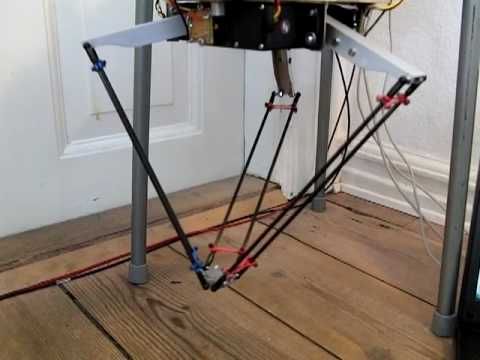 The print head weighs less than 50 grams, and the three stepper motors have significant holding torque even when they are turned off (permanent magnets). You can move the print head around with your hand when the motors are turned off, but it's not very easy, and it will stay where you put it.
The print head weighs less than 50 grams, and the three stepper motors have significant holding torque even when they are turned off (permanent magnets). You can move the print head around with your hand when the motors are turned off, but it's not very easy, and it will stay where you put it.
- How do I calibrate axis_steps_per_unit ?
You don't need to "move and measure" if you know the pitch and number of teeth on your pulleys. Simply enter your pulley size on http://calculator.josefprusa.cz/#MotorStuffSPMB and it will do the math and show you the result. The firmware takes care of all the non-linear math so you don't have to include that in this number. If you do want to "move and measure", use Z movement, because X and Y are non-linear.
- What's the resolution in X/Y direction ?
The steps per mm for X and Y is not constant across the print area. In the middle it is around 30 steps per mm, and near the edge it's more than 300 steps per mm because the push rods will be nearly horizontal.
- Is it possible to mount a cooling fan on the print head carriage ?
It is possible but I was trying to reduce the weight of the moving parts. So I'm using a large oscillating desk fan sitting next to the printer. You can see the fan in this picture: http://thingiverse.com/image:150904
- How many bearings are actually used ?
3x 608ZZ and 3x F608ZZ (F = flanged) for the timing belt idlers at the top. If you can't find flanged bearings, you can try using normal 608ZZ with a printed plastic flange. If you want to use smaller timing belt pulleys on the motors (which might be a good idea) you could also replace 608 (8x22x7 mm) with 688 (8x16x6 mm) or similar.
Also 1x 608ZZ and 1x MR105ZZ for Airtripper's direct drive bowden extruder.
- How do you pronounce "Rostock"? Roe-stock, Raw-stock, Roz-talk ?
It's open source, you can pronounce it how you want. ;)
I say Ross-tock but your other pronunciations are fine too.
- Would you recommend 0.9 degree per step or 1.8 degree per step motors ?
Use whatever you have in your workshop. If you are buying new motors, I think 1.8 degree per step (200 full steps per rotation) is more common for RepRap printers these days. Modern electronics (e.g. the RAMPS 1.4 which I currently use) support 16x micro stepping, so there are 3200 micro steps per rotation which is plenty.
- Can you publish a schematic diagram of the electronic connections ?
The wiring is very similar to Prusa Mendel for example. I wired my endstops "normally connected" so the circuit is interrupted when the endstop is hit. But that's easy to change in the firmware configuration.
- Can Rostock print a full 11.31" diameter circle ?
The current prototype can't really print the full 8x8inch (20.32cm) heated bed. It's closer to a 9 inch (22.86cm) circle. But yes you can print a vase with overhang that is wider than the print surface.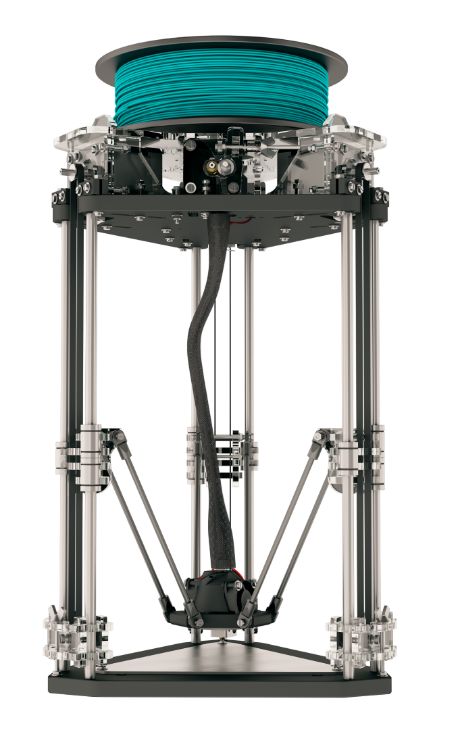
- Where can I buy a kit with parts to build my own Rostock ?
Sorry, not yet. This is really still a prototype. I'm pretty sure that the first beta testers are going to find several problems and make improvements. We are working on a new frame called Kossel to replace the plywood frame with OpenBeam, and so far it's looking pretty good. Stay tuned!
In Europe you can find a full kit from Reprap Austria
- Do you have any backlash problems with the metal-on-plastic universal joints ?
In an earlier version some of these screws unscrewed themselves after a while, but I think that is completely solved by the inside counter nuts. My prototype has only printed about 1 kg of PLA, but so far there is no sign of wear and very little backlash.
- Why do you have longer than "standard" LM8UU bearings on some of the rods ?
The longer LM8LUU was just an experiment to see if it would keep the carriage more horizontal. It doesn't seem to make a difference, except for added cost and weight, so it's not recommended.
- How low do the carriages need to slide on the rods during the printing/operation ?
The diagonal suspension rods are 250 mm long so the max required carriage travel for printing the first layer is somewhere around 200 mm (they go from vertical to almost horizontal). You need to add the build height to the first layer travel: 200 mm + 200 mm = 400 mm carriage travel required if you want to print objects up to 200 mm tall.
- What length are the belt loops ?
My prototype currently uses 762 mm smooth rods and GT2 timing belt loops with 2 mm pitch and 762 grooves. This gives me 8x8x16 inches (20x20x40 cm) build volume. You can make your Rostock taller or shorter simply by adjusting the length of the smooth rod and timing belts. If you already have shorter belts, you can use them with longer smooth rod too. The extra smooth rod may stick out the top of your printer, but that's okay. A shorter printer may be more rigid / stable and may not need the extra plywood frame on the back and side.
- Why did you build three towers instead of four ?
I decided to start with three towers, to build the simplest design that could possibly work. Four towers might improve precision, but it also needs 33% more parts and it would be over-constrained. This means the mechanics might jam if the four sides are not coordinated exactly right.
Future
The following improvements are planned for future versions:
- Use smaller timing belt pulleys and idler bearings.
- Find cheaper timing belts and pulleys, e.g. T2.5 / HTD-3M / GT3?
- Replace timing belts with Spectra fishing line.
- Write a new clean delta firmware based on Grbl.
- Create a Mini Rostock variation with 120x120x120 mm build volume.
- Replace metal binder clips with printed plastic clips to hold the glass platform.
- Use OpenBeam aluminum extrusion instead of plywood frame: Kossel.
- Use OpenRail (or hybrid roller slide directly on OpenBeam) instead of LM8UU and smooth rods.

- Experiment with dual extruders.
Links
- Rostock blog on Tumblr
- Videos on YouTube
- Pictures on Flickr
- Rostock parts on Thingiverse
- Mailing list for questions and answers
- OpenSCAD source files on GitHub for printed plastic parts.
- Modified Marlin firmware on GitHub for delta geometry on Arduino.
- Bill of materials / BOM / parts list on Google Docs (work in progress)
Rostock - RepRap
Rostock Documentation
Main page | Rostock Buyer's Guide | Rostock Build Manual | Rostock User Manual | Rostock improvements
Rostock
Release status: working
| Description | Rostock is a delta robot 3D printer prototype. |
| License | GPL |
| Author | User:Johann |
| Contributors | |
| Based-on | Helium Frog Delta Robot |
| Categories | Delta, Tall |
| CAD Models | GitHub |
| External Link | Thingiverse |
Rostock is a linear delta robot 3D printer prototype, built in 2012 by Johann in Seattle, USA.
Several variations have taken root, including: Kossel, Rostock mini, Rostock MAX, Rostock-Montpellier, Rostock Prisma, Delta-Pi, Cerberus, cOssel, Cherry Pi and ProStock. Both the MOST delta and their Open Source Metal 3D Printer also uses an inverted form of this design.
Contents
- 1 Design Goals
- 2 Videos
- 3 Firmware
- 4 Frequently Asked Questions
- 5 Future
- 6 Links
Design Goals
- Build volume: 200x200x400 mm (8x8x16 inches).
- Footprint: 300x350 mm (12x14 inches).
- Print surface: 200x200 mm heated glass which never moves.
- Mass of end effector with hotend: less than 50 grams.
- Positioning speed: up to 800 mm/s in all 3 directions.
- Positioning accuracy: at least 30 steps/mm in all 3 directions.
- Simplicity: fewer than 200 parts.
- Hardware cost: less than $500 USD.
Videos
http://youtube.com/user/jcrocholl/videos?query=rostock
<videoflash>3UOq-CQsbNo|640|360</videoflash>
<videoflash>nkAwOxA0lq8|640|360</videoflash>
Firmware
Many firmwares support Delta printers out of the box. See their individual instructions on how to configure them.
See their individual instructions on how to configure them.
Frequently Asked Questions
- How do you adjust the height of the print surface ?
You can adjust the following line in Configuration.h and then recompile and upload the firmware:
// The home position of the print head. // For Rostock this means top and center of the cartesian print volume. #define Z_HOME_POS 402 // Distance between nozzle and print surface after homing.
For micro-calibration, use the adjustable endstop screws in the vertical carriages, see #Calibration above.
- Should the heat bed be mounted on top of a piece of insulation or cork ?
Yes, it's definitely a good idea. Cork or another kind of thermal insulation under the heatbed has two benefits:
- It lowers the times required for the heatbed to reach the PLA (around 60C) or ABS (around 100C) ideal heatbed temperatures.
- It protects whatever material is under the heatbed from excessive heat radiated by the hot heatbed.
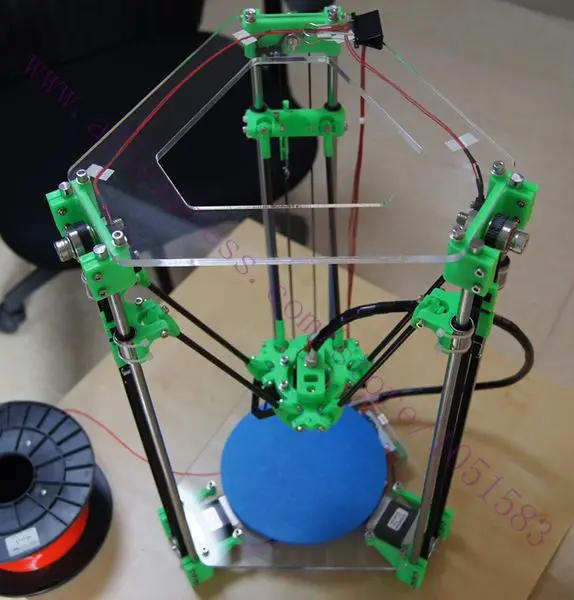
See Heated Bed Insulation for further details.
- Is your heat bed mounted element side up ?
Yes, the etched copper side is in direct contact with the glass. You can see the LEDs and contacts in the front just next to the glass edge. But I have not actually connected my heated bed wires yet, because I print only PLA and it sticks perfectly to blue painters tape, even without heating the platform. I will connect the heated bed wires if I ever have problems with detaching corners, otherwise remove the heated bed completely at some point.
- Should the heat bed be mounted so it can be leveled ?
No, I think the print platform should be attached as tightly as possible to the frame, with full surface contact, possibly with cork insulation between bed heater and plywood. Then you can level the first print layer with the three micro-adjustable endstops, see #Calibration. Also make sure that the vertical smooth rods are orthogonal to the bottom plywood, otherwise your printed objects will be slightly skewed.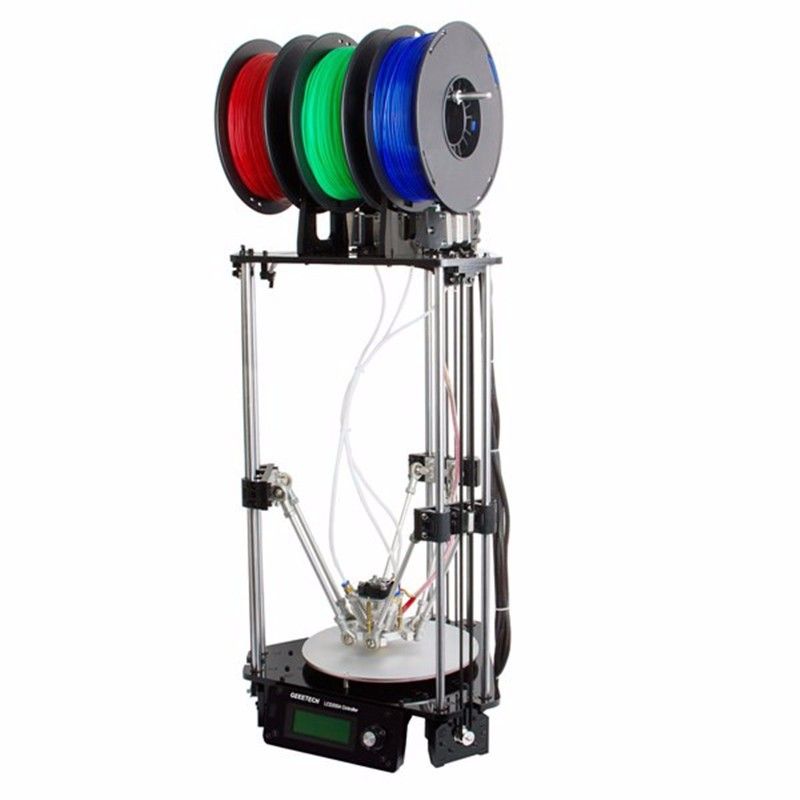
- Will it matter if the hot end is not centered in the platform opening ?
It might work okay but there are some minor issues:
- You may need to design and print a special asymmetric attachment for the bowden tube.
- The nearest inside of the moving platform may get soft because of the heat from the hotend.
- Your prints will not be centered on the print surface (closer to one edge) but this may be adjusted in your Slicer settings.
- Why does the printer pause sometimes ?
Print with pronsole.py instead of pronterface.py if your prints have warts. They may be caused by Pronterface redrawing the G-code view while printing, which creates significant delay between segments. My modified Marlin firmware generates many shorter lines for each G1 command, so the Marlin look-ahead buffer will run empty if you don't send the next G1 command ASAP. This can also be solved by printing directly from SD card.
- If Rostock loses power, does the print head fall down ?
No. The print head weighs less than 50 grams, and the three stepper motors have significant holding torque even when they are turned off (permanent magnets). You can move the print head around with your hand when the motors are turned off, but it's not very easy, and it will stay where you put it.
The print head weighs less than 50 grams, and the three stepper motors have significant holding torque even when they are turned off (permanent magnets). You can move the print head around with your hand when the motors are turned off, but it's not very easy, and it will stay where you put it.
- How do I calibrate axis_steps_per_unit ?
You don't need to "move and measure" if you know the pitch and number of teeth on your pulleys. Simply enter your pulley size on http://calculator.josefprusa.cz/#MotorStuffSPMB and it will do the math and show you the result. The firmware takes care of all the non-linear math so you don't have to include that in this number. If you do want to "move and measure", use Z movement, because X and Y are non-linear.
- What's the resolution in X/Y direction ?
The steps per mm for X and Y is not constant across the print area. In the middle it is around 30 steps per mm, and near the edge it's more than 300 steps per mm because the push rods will be nearly horizontal.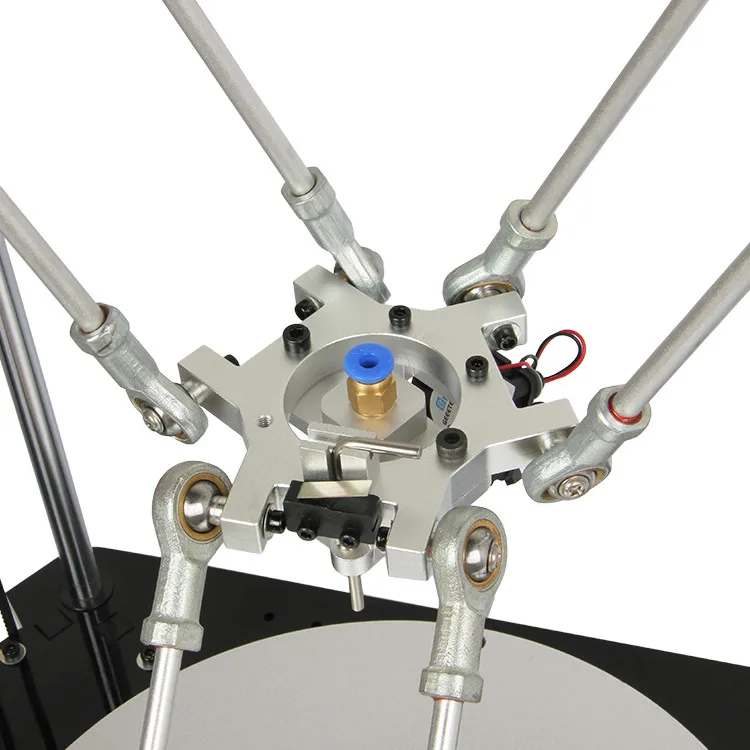
- Is it possible to mount a cooling fan on the print head carriage ?
It is possible but I was trying to reduce the weight of the moving parts. So I'm using a large oscillating desk fan sitting next to the printer. You can see the fan in this picture: http://thingiverse.com/image:150904
- How many bearings are actually used ?
3x 608ZZ and 3x F608ZZ (F = flanged) for the timing belt idlers at the top. If you can't find flanged bearings, you can try using normal 608ZZ with a printed plastic flange. If you want to use smaller timing belt pulleys on the motors (which might be a good idea) you could also replace 608 (8x22x7 mm) with 688 (8x16x6 mm) or similar.
Also 1x 608ZZ and 1x MR105ZZ for Airtripper's direct drive bowden extruder.
- How do you pronounce "Rostock"? Roe-stock, Raw-stock, Roz-talk ?
It's open source, you can pronounce it how you want. ;)
I say Ross-tock but your other pronunciations are fine too.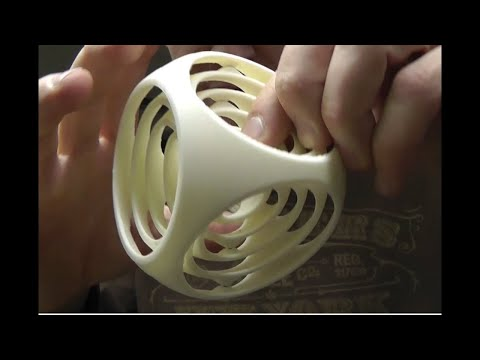
- Would you recommend 0.9 degree per step or 1.8 degree per step motors ?
Use whatever you have in your workshop. If you are buying new motors, I think 1.8 degree per step (200 full steps per rotation) is more common for RepRap printers these days. Modern electronics (e.g. the RAMPS 1.4 which I currently use) support 16x micro stepping, so there are 3200 micro steps per rotation which is plenty.
- Can you publish a schematic diagram of the electronic connections ?
The wiring is very similar to Prusa Mendel for example. I wired my endstops "normally connected" so the circuit is interrupted when the endstop is hit. But that's easy to change in the firmware configuration.
- Can Rostock print a full 11.31" diameter circle ?
The current prototype can't really print the full 8x8inch (20.32cm) heated bed. It's closer to a 9 inch (22.86cm) circle. But yes you can print a vase with overhang that is wider than the print surface.
- Where can I buy a kit with parts to build my own Rostock ?
Sorry, not yet. This is really still a prototype. I'm pretty sure that the first beta testers are going to find several problems and make improvements. We are working on a new frame called Kossel to replace the plywood frame with OpenBeam, and so far it's looking pretty good. Stay tuned!
In Europe you can find a full kit from Reprap Austria
- Do you have any backlash problems with the metal-on-plastic universal joints ?
In an earlier version some of these screws unscrewed themselves after a while, but I think that is completely solved by the inside counter nuts. My prototype has only printed about 1 kg of PLA, but so far there is no sign of wear and very little backlash.
- Why do you have longer than "standard" LM8UU bearings on some of the rods ?
The longer LM8LUU was just an experiment to see if it would keep the carriage more horizontal. It doesn't seem to make a difference, except for added cost and weight, so it's not recommended.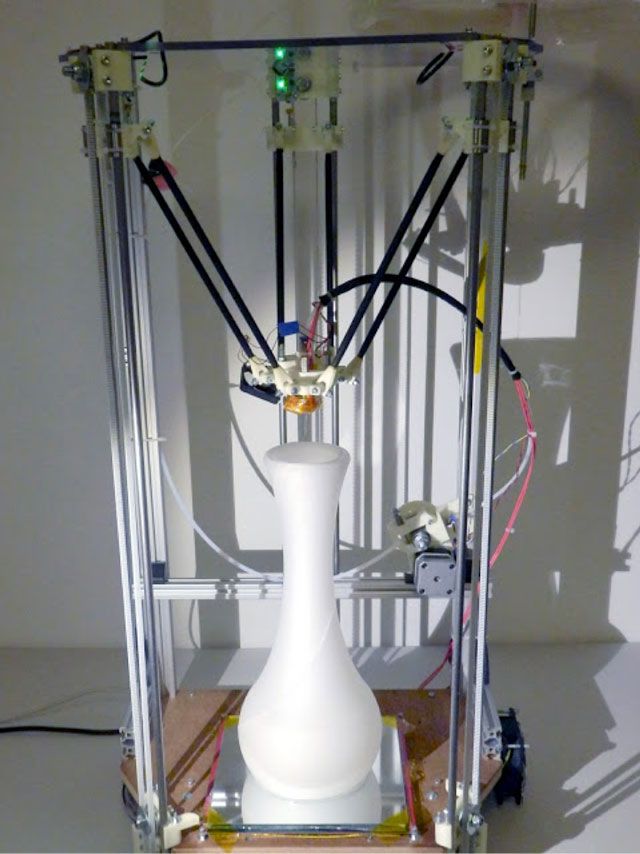
- How low do the carriages need to slide on the rods during the printing/operation ?
The diagonal suspension rods are 250 mm long so the max required carriage travel for printing the first layer is somewhere around 200 mm (they go from vertical to almost horizontal). You need to add the build height to the first layer travel: 200 mm + 200 mm = 400 mm carriage travel required if you want to print objects up to 200 mm tall.
- What length are the belt loops ?
My prototype currently uses 762 mm smooth rods and GT2 timing belt loops with 2 mm pitch and 762 grooves. This gives me 8x8x16 inches (20x20x40 cm) build volume. You can make your Rostock taller or shorter simply by adjusting the length of the smooth rod and timing belts. If you already have shorter belts, you can use them with longer smooth rod too. The extra smooth rod may stick out the top of your printer, but that's okay. A shorter printer may be more rigid / stable and may not need the extra plywood frame on the back and side.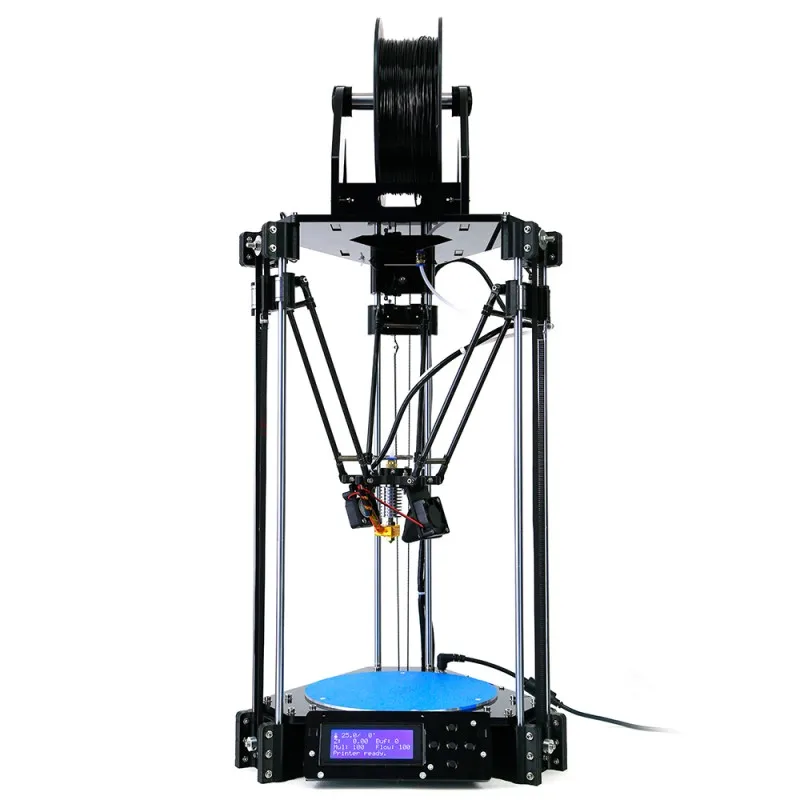
- Why did you build three towers instead of four ?
I decided to start with three towers, to build the simplest design that could possibly work. Four towers might improve precision, but it also needs 33% more parts and it would be over-constrained. This means the mechanics might jam if the four sides are not coordinated exactly right.
Future
The following improvements are planned for future versions:
- Use smaller timing belt pulleys and idler bearings.
- Find cheaper timing belts and pulleys, e.g. T2.5 / HTD-3M / GT3?
- Replace timing belts with Spectra fishing line.
- Write a new clean delta firmware based on Grbl.
- Create a Mini Rostock variation with 120x120x120 mm build volume.
- Replace metal binder clips with printed plastic clips to hold the glass platform.
- Use OpenBeam aluminum extrusion instead of plywood frame: Kossel.
- Use OpenRail (or hybrid roller slide directly on OpenBeam) instead of LM8UU and smooth rods.
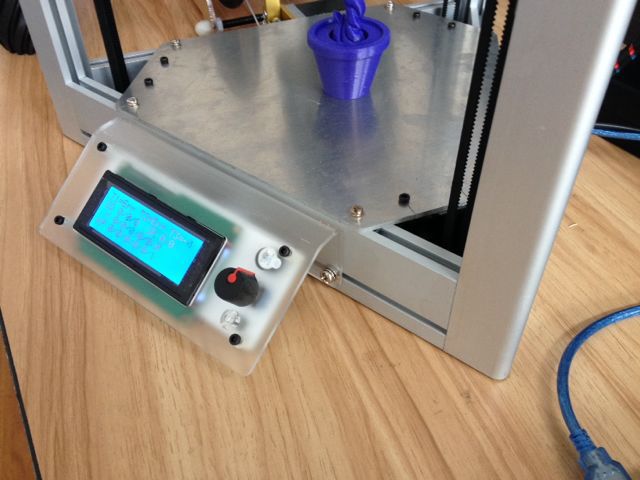
- Experiment with dual extruders.
Links
- Rostock blog on Tumblr
- Videos on YouTube
- Pictures on Flickr
- Rostock parts on Thingiverse
- Mailing list for questions and answers
- OpenSCAD source files on GitHub for printed plastic parts.
- Modified Marlin firmware on GitHub for delta geometry on Arduino.
- Bill of materials / BOM / parts list on Google Docs (work in progress)
Rostock (delta robot 3D printer) free 3D file・3D print model for download・Cults
Vert-X-Belt-Truder
Free
Motor end for Rostock
Free
Vertical carriage for Rostock
Free
Printable drill jig for Rostock plywood parts
Free
Idler end for Rostock
Free
Diagonal rod for Rostock
Free
PG35L extruder for Kossel
Free
Bowden clamp for Rostock
Free
The best files for 3D printers in the Tools category
Charging shelf
Free
Flexbot-hexacopter
Free
Standard Screwdriver
Free
Skull Bottle Opener
5 €
Cotton swab holder
€1. -twenty% 1.34 € 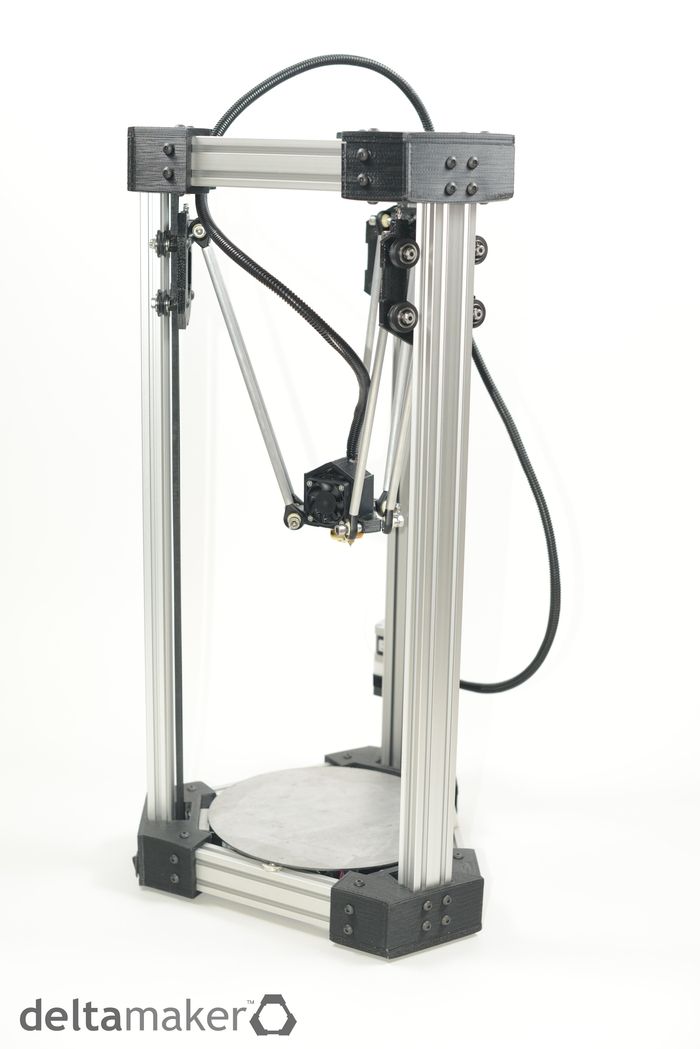 68
68
Painter Bundle
11 €
Turboprop Engine
Free
FFP2 paper mask
Free
Bestsellers in the Tools category
Cooling system Minimus Hotend
2.35 €
PRECISION CALIPER 3D PRINT DIY
3,11 €
ENDER 3 S1/S1 PRO COIL HOLDER AND DEPORTED COIL
€2.13 -twenty% 1.71 €
Armadillo - flexible wire conduit
1.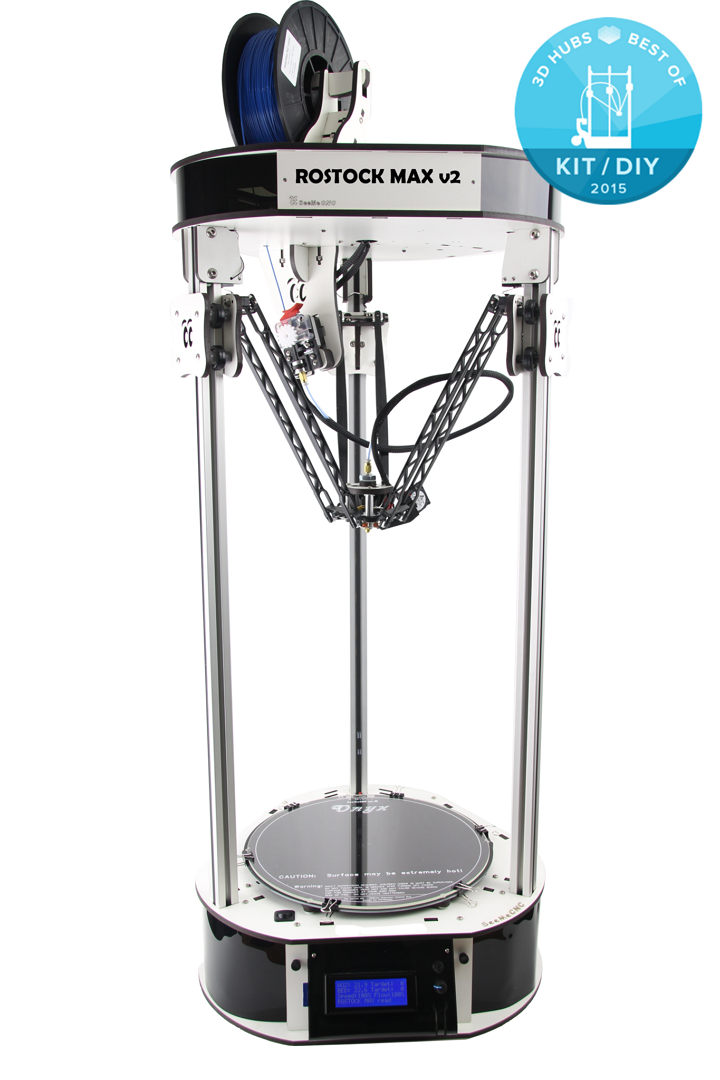 69 €
69 €
well designed: Hemera fan duct
2.50 €
Bit holder Spartan 4 mm Hex
1,80 €
INDICATOR FOR BETTER BED LEVELING FOR ENDER 3 V2
2.84 €
Tool holder for 3D printer V3.0
1.04 €
Bambu AMS Stand for placing the raised 2nd block behind
1.15 €
209 Flash Bang / Ukrainian Hot Potato
0,95 €
ENDER 3 S1/PRO SPRITE, V3 AIR DUCT 5015 OR 4020, LED Strip
€2.69 -twenty% 2.15€
PET-Machine, make your own plastic bottle filament at home!
15 €
Paint stand with scissors
5.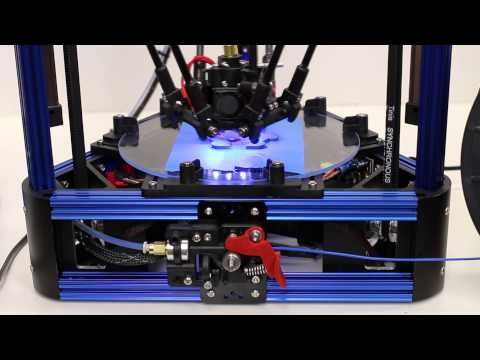 24 €
24 €
PRECISE DIAL INDICATOR 3D PRINT DIY
1,90 €
Display holder FLSUN v400
9.99€ -fifty% 4.99 €
Spartan pen holder
1,80 €
Do you want to support Cults?
Do you like Cults and want to help us continue our journey on our own ? Please note that we are a small team of 3 people , so support us in keeping the activity going and making future designs of is very easy. Here are 4 solutions available to everyone:
-
AD: Disable your AdBlock banner blocker and click on our banner ads.
-
AFFILIATION: Shop online with our affiliate links here Amazon.
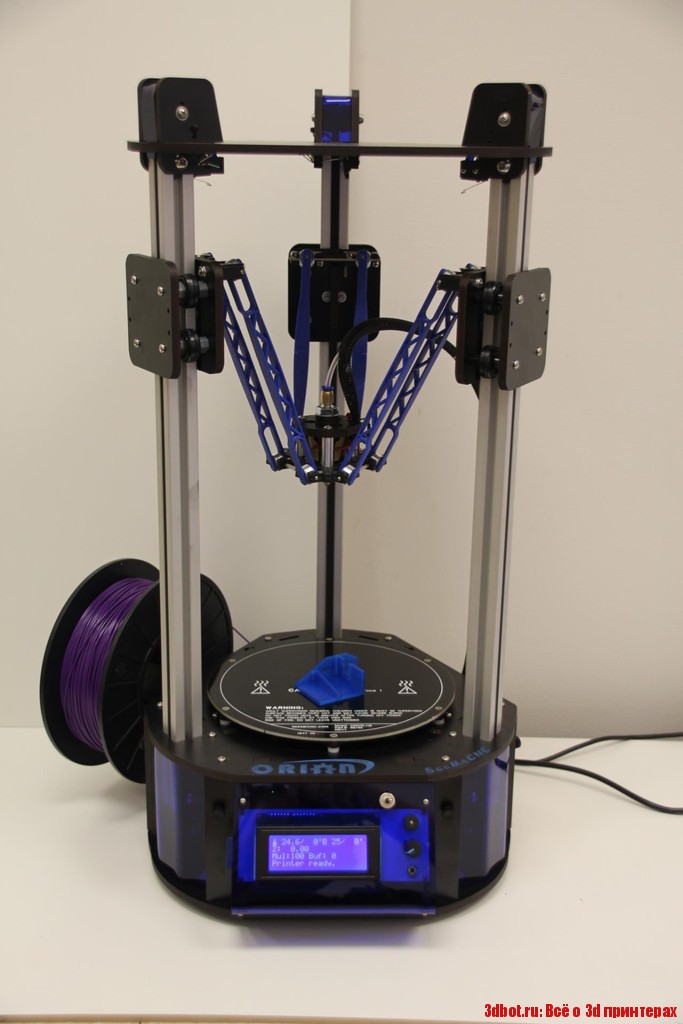
-
DONATIONS: If you want, you can donate via PayPal here.
-
* INVITE FRIENDS: * Invite your friends, discover the platform and great 3D files shared by the community!
Answers to questions about kossel
For questions about the Kossel family of printers in particular. Questions about Delta printers in general have their own tag.
This tag is for questions specifically about the Kossel family of printers. Questions about delta 3D printers usually have their own tag.
Kossel 3D printer is a parametric delta printer based on Rostock 3D printer. From RepRapWiki - Kossel:
Kossel is a delta robot parametric 3D printer built in 2012 by Johann in Seattle, USA, based on his Rostock prototype.
It is named after Albrecht Kossel, a German biochemist and pioneer in the study of genetics. He was awarded the Nobel Prize for Physiology or Medicine in 1910 for his work on the definition chemical composition of nucleic acids, genetic substance biological cells.

The original printer has spawned a number of derivatives that differ mainly in their size, but which basically have the same design. Again, from RepRapWiki - Kossel:
History
There are several printers in the Kossel family.
Kossel Heritage
- Spectrum line instead of timing belt.
- 623 bearings running directly on a 15 x 15 mm vertical aluminum extrusion such as OpenBeam, 6 bearings per bottom bracket.
- Extruder PG35L directly on the end effector (moving platform).
- This design has been deprecated, but the source files are still available.
OpenBeam Kossel Pro
- Designed by Terence Tam for mass production.
- Successfully funded on Kickstarter.
- Stamped and injection molded parts instead of 3D printing.
Mini Kossel
- This is the latest and stable version of Johann.

- The rest of this page describes the details of the Mini Kossel.
There are other (usually larger) projects from other authors, namely Terence and David Crocker , among others.
The original goals of this particular delta style printer design, as opposed to the more traditional cartesian style designs that exist, are as follows:
Design Objectives
- Zero backlash.
- Type: Delta Printer
- Speed: 320 mm/s in all 3 directions.
- Resolution: 100 steps/mm in all 3 directions.
- Repeatability: greater than 0.03 mm (30 microns)
- Assembly volume: cylindrical, diameter 170 mm, height 240 mm.
- Size: triangle, width 300 mm (240 mm open beam + printed corners).
- Frame height: 600 mm.
- Print surface: unheated round glass, does not move.
- Weight of end effector with hotend: less than 50 grams.
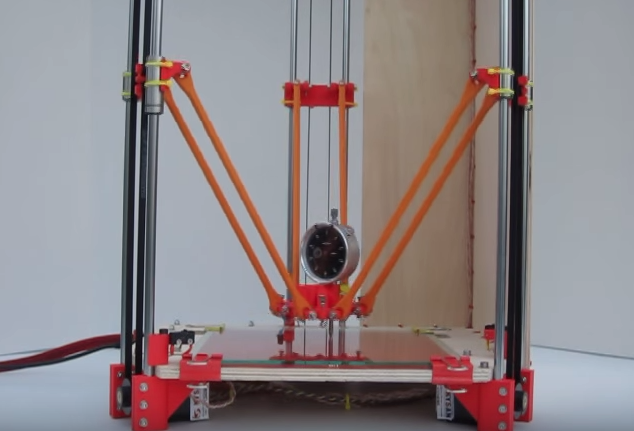
- Simplicity: less than 200 parts.
- Hardware cost: less than $600.
- Fully automatic print surface level calibration (auto leveling).
(Source: RepRapWiki - Kossel)
- Printing half size after replacing board I recently burned one of the MOSFETs on my RAMPS 1.4 board on my Sintron Kossel clone so I upgraded to RAMPS 1.6. Now my printer only prints 50% of the intended size...
- How to align the endpoints of the kossel? My printer is kossel (delta 3d printer). I have a probe far from the nozzle (offset -x45 y17), every time I run a G29 the result is unacceptable, distance z between points exceeds 0.5mm,…
- Anycubic Kossel Delta switch from Trigorilla to MKS Gen L 1.0 I have an Anycubic Kossel Delta 3D printer. The original Trigorilla motherboard died and I decided to buy it but only found the Makerboard MKS Gen L 1.0 which is said to be compatible with…
- How to replace Trigorilla motherboard with MKS Gen L 1.
 0 I have the following printer: Anycubic Kossel. It has a Trigorilla motherboard. My motherboard is dead and replacing it with another Trigorilla motherboard is very expensive or almost...
0 I have the following printer: Anycubic Kossel. It has a Trigorilla motherboard. My motherboard is dead and replacing it with another Trigorilla motherboard is very expensive or almost... - Marlin: Switch Y to E1 I have an Anycubic Kossel with a Trigorilla motherboard, Mega2560+RAMPS1.4. I am using Marlin 2_0_bugfix My Y-connector is no longer working, so I would like to use the E1 connector in…
- Looking for files for printed parts for my Kossel XL kit from Builda3Dprinter.eu A couple of years ago I got a Kossel XL kit from builda3dprinter.eu as a gift, but I stopped building it because a few parts were missing, including printed parts . Now that I'm building...
- Partial underextrusion in the walls I'm encountering strange underextrusion "pillars" on the outer walls of my XYZ test cube. In the pictures below, I printed PLA test cubes with a 0.4mm nozzle, 0.2mm height, and a temperature of…
- Anycubic Kossel Plus raises the print head too high on the corners of the table if the print is too close to the corners Hi guys, I'm quite new to 3d printing.
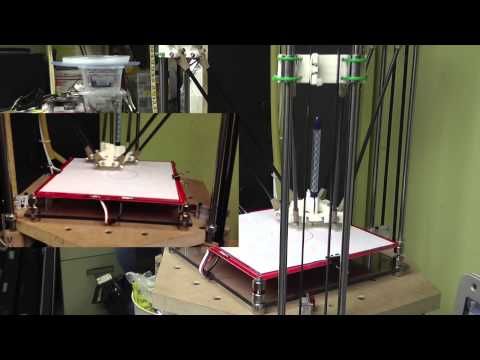 I have this issue with the print head rising too high during printing as it gets close to the edge of the table. This is not a problem with…
I have this issue with the print head rising too high during printing as it gets close to the edge of the table. This is not a problem with… - LV8729 about kossel issues with print sizes (steps) I installed an LV8729 on a kossel configured with SKR 1.3 and marlin 2.0 with all jumpers configured the same for 16 micro steps in X Y Z. Everything seems fine, the printer…
- Getting wrong measurements on my Kossel Linear Plus after installing SKR 1.3 with Marlin 2.0 So I replaced the Trigorilla board in the printer with SKR 1.3 with TMC2208 drivers and installed the latest Marlin 2.0 with a configuration based on this . You can find the config.h here…
- How to Build an Extruder Motor Holder for Kossel Mini I'm building a mini Kossel and I'm stuck on the extruder motor holder. My Kossel came without instructions, I was given a set of instructions by a friend ("Kossel Assembly Guide" by Blomker industries). I…
- XY plane distortion calibration in Repetier I built a delta 3d printer (eg mini Kossel) and am now trying to calibrate it.
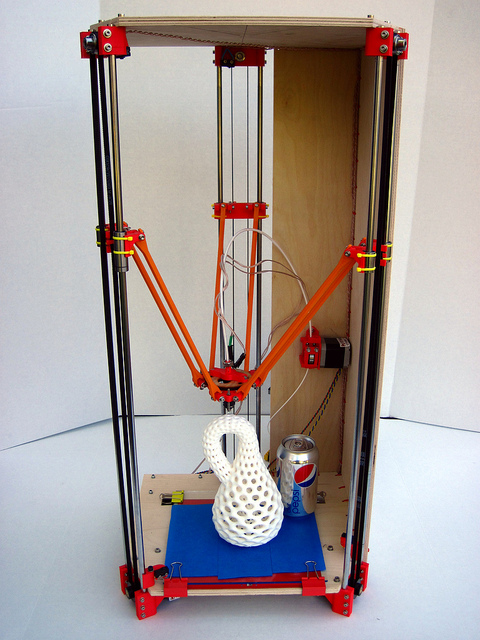 I made all the horizontal and vertical rods myself out of wood and bought the gussets (between the rods)…
I made all the horizontal and vertical rods myself out of wood and bought the gussets (between the rods)… - What are the changes in this Kossel? (This question is sort of a self-answer. I know who made this printer, he explained the modifications and I thought it might be of interest to others as well. I asked him to answer this…
- Kossel clone print quality for Print in Place models My first printer is a Delta style Kossel clone and I have no luck with Print In Place (PIP) models, especially with hinges. I suspect my printer simply can't achieve low enough tolerances...
- Delta printer offset on first few layers On first few layers, each layer has an offset in the -X/-Y direction on the previous layer. But above ~2 mm it is vertical. I checked the printer assembly that there is no noticeable error in the towers. Tried…
- How to draw a delta kossel angle in fusion 360? I want to draw delta kossel angle in fusion 360 for 2040 aluminum extrusion like below picture but can't find a way to actually start, I draw 3 side polygons and a rectangle…
- Pronterface not connecting to Anycubic Kossel Linear Plus Anycubic Kossel Linear Plus I have to upload data to the 3D printer from a software called Arduino and then close it.
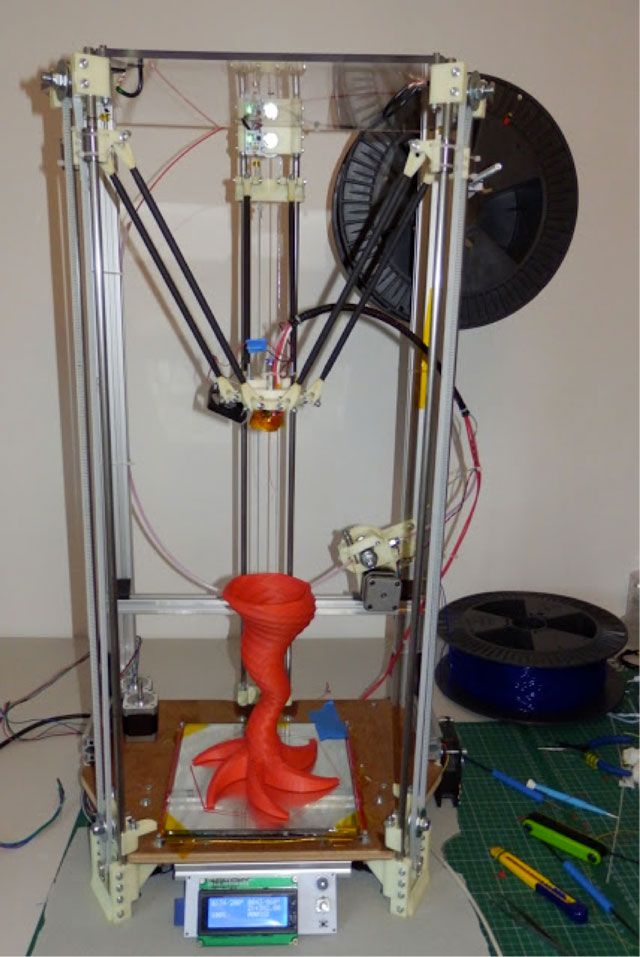 Then I open Pronterface and put in the right port and…
Then I open Pronterface and put in the right port and… - Complete list of fasteners for Sintron Kossel TL;DR I need a complete list of fasteners (bolts, nuts and washers) for Sintron Kossel. Has anyone bought this kit and knows the answer, or knows where it's documented? Full list...
- Kossel is accumulating error along the Z axis I have a mini Kossel and I am calibrating. I can go home and find a paper table - a test getting some Z value with M114 . Then I run the effector almost all the way...
- Table leveling method not working with Repetier firmware 0.92.9? I built a delta 3d printer (e.g. Kossel mini) with Z-probe next to hotend with manual deployment and RAMPS 1.4 board: I set up the Repetier firmware with an online tool; All my…
- How long are Traveling Kossel carbon rods? TL; DR - For a given Kossel frame size (taking into account the vertical and horizontal lengths of the aluminum extrusion frame), what would be the length of the carbon fiber bars? As an example from .
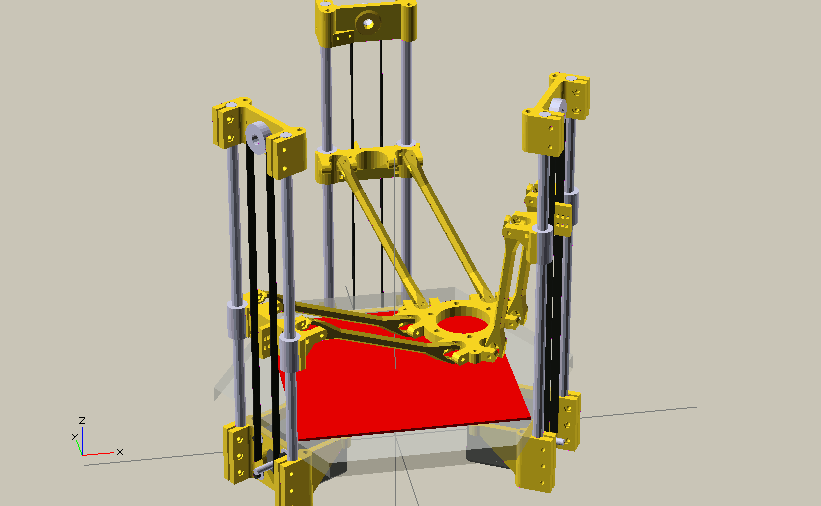
Learn more


